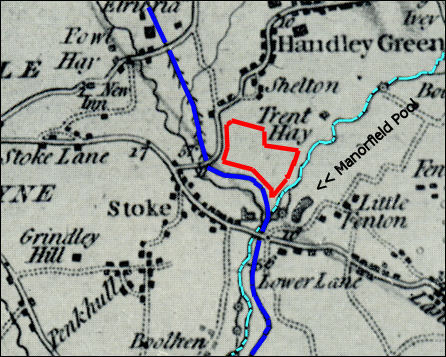|
Winton Square
- 'The best face of the Potteries'
  
click the "contents"
button to get back to the main index & map
next: Stoke Road, Howard Place & Snow Hill
previous:
Lower Lane
|
Historian Fred Hughes writes....
Looking across the dark water of Manorfield Pool, I can just about
follow the line of the old Roman road as it leaves Little Fenton. It must have cut across the tip of Fenton Manor Leisure complex, but
then it becomes lost in the huge crater of an industrial marl hole.

Fenton Manor marl hole
"The road passed where we're standing," agrees my companion, historian
Steve Birks. "Then I think it filed along Wintonfield Street and into
Station Road. And from here it disappears completely beneath a chaos of
road and rail.
"But can you imagine how idyllic it must have looked in Roman times set
on this lower level of Shelton?"
One map, dated 1775, shows a lane leaving the old road at this point
along the present Shelton Old Road and through what is now Stoke Road to
Snow Hill. The area between this road and the River Trent was known as
Winton's Wood and Winton's Field.

Yates 1775 map showing
the Manorfield pool and Winton Fields
"Another map dated 1800 shows 150 acres of the Stoke Church estate,"
says Steve. "A third of this is in the township of Penkhull, a third in
Fenton and a third in Shelton. It is this last part that includes Winton's
Field and Winton's Wood. At the centre of this today is Station Road, the
railway station and the North Stafford Hotel, beneath which the Roman Road
is buried."
I've always believed this location to be the primary gateway into
Stoke-on-Trent and I'm about to find out why it was chosen.
|
"Winton Square was definitely designed to present the best face as you
arrived in the Potteries," says Steve. "The station was inspirationally
put together to suit the dimensions of a European classical square with
Flemish
gables fronted with classical columns and a carved stone canopy
Although it is modest in comparison with other British terminuses, it is
its simplicity that sets it alight."
Completed in 1848 by H. A. Hunt and commissioned by the North
Staffordshire Railway Company, the station is constructed in brick and
sandstone to a beautifully detailed Elizabethan and Jacobean design. It
even brought a compliment from one exacting critic of Stoke-on-Trent,
Nikolaus Pevsner, who described the Potteries in 1974 as 'an urban
tragedy'.
"Despite Pevsner's criticism, he stated that Winton Square was a fine
example of Victorian planning in Staffordshire," adds Steve. "And civic
and cultural leaders have • acknowledged this by listing no less than
eight buildings here."
Steve goes further.
"I mean just look at the splendid North Stafford Hotel, built in the
same style in 1849 a year after the station opened."

North Stafford Hotel
"Stoke-on-Trent possesses one of the finest gateways in
the country in Winton Square; step off the train in Stoke-on-Trent and you
are met with one of the finest examples of Victorian urban planning you
are likely to come across, and two great landmarks in Stoke-on-Trent
Railway Station and the North Stafford Hotel, both of which are Grade II*
Listed."
David Proudlove - Regeneration Manager for English
Partnerships
|
The name Winton is obviously significant, but where does it come from?
The answer to this is provided by one of the city's principal academic
historians, Richard Talbot.
"Winton land was originally owned by the rectory of St Peter ad Vincula,"
explains Richard. "It was named after John Sandale, one of the church's
rectors who lived between 1274 and 1319. And before you say Sandale sounds
nothing like Winton, let me tell you the story.....
|
"Sandale was a beneficiary of court nepotism and patronage. By the age
of 20 he was one of Edward II's clerks and became Chancellor of the Exchequer in 1307. Between 1305 and 1316, Sandale was the rector
of Stoke and yet he'd probably hardly ever set foot in the parish. How did
all this happen? It was through the sponsorship of the powerful Thomas,
Earl of Lancaster.
"It may be hard to believe but Stoke parish was at the time the third
wealthiest in the country
"Anyway, in 1316, Sandale was promoted to Bishop of Winchester and as
such would sign his name John Winton. Around the same time, the chancel to
Stake's Saxon church was redeveloped and the timber would have been cut
from the church lands. I believe the area then became known as Winton's
Wood because of the connections to Stake's former rector.
"John Sandale of course wasn't local. Nevertheless, his appointment as
a bishop to the important diocese of Winchester doubtless was used by Stoke parish to
reflect connections with Sandale's reputation."
|
Winton Square, of course, is in Shelton and with implausible irony the
station looks away from Stoke to face Hanley.
"But it's possibly because of the location of Winton Square that
Stoke-on-Trent has survived as a city," says Richard.
"Before the canal there were six small industrial centres dotted around
a rich coalfield, independent and loosely connected. James Brindley and
Wedgwood saw the Fowlea Valley as the logical communications link to the
west and the east coasts; sixty-odd years later the railway followed the
same valley contours, and that kept the industry here. Can you imagine
Stoke on Trent without this line of communication?”
I’m guessing the major pottery industry would have been moved nearer
the seaports; the cluster of towns would have continued mining coal
independently, civic development would have been arbitrary and just maybe
there wouldn’t have been a City of Stoke on Trent at all.
 on Winton's Field area
on Winton's Field area
next week: Stoke Road to Howard Place & Snow Hill
  
click the "contents"
button to get back to the main index & map
next: Stoke Road, Howard Place & Snow Hill
previous:
Lower Lane
|